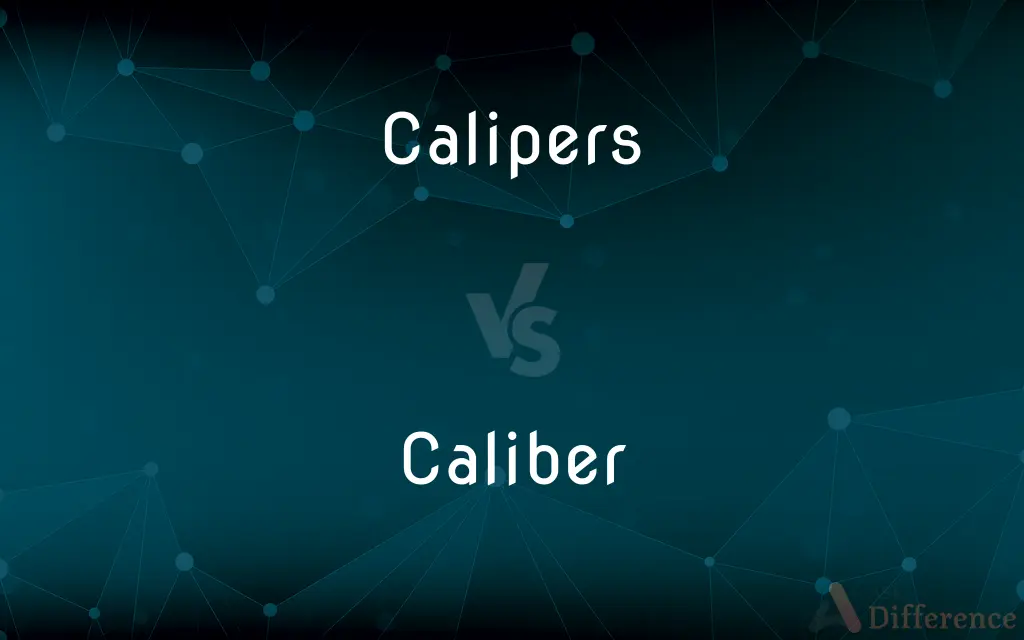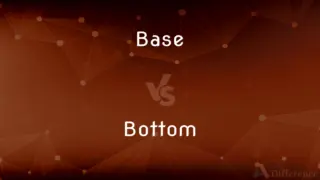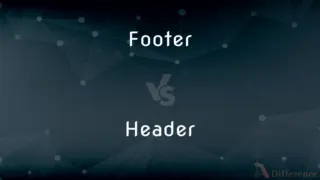Calipers vs. Caliber — What's the Difference?
By Tayyaba Rehman & Fiza Rafique — Updated on March 20, 2024
Calipers measure thickness or diameter of objects, while caliber is a measurement of diameter, often of gun barrels and bullets.

Difference Between Calipers and Caliber
Table of Contents
ADVERTISEMENT
Key Differences
Calipers are precision instruments used for measuring the distance between two opposite sides of an object. They come in various forms, including vernier, dial, and digital, offering precise measurements for engineering, manufacturing, and woodworking applications. On the other hand, caliber refers to the internal diameter or bore of a gun barrel, or the diameter of a projectile used in firearms. It is a critical specification for firearms and ammunition, determining the size and type of projectile that can be fired.
While calipers are versatile tools used across many industries for detailed measurements, caliber is a specific term used primarily in the context of firearms and ammunition. Caliber measurements are crucial for the safe and effective operation of firearms, ensuring that the ammunition matches the firearm's specifications. In contrast, calipers are essential for quality control, design, and manufacturing processes, providing accurate measurements that can be critical to the success of a project.
Calipers can measure a wide range of dimensions, including internal, external, depth, and step measurements, making them indispensable in settings that require high precision. Caliber, however, is used to classify firearms and ammunition, playing a vital role in the selection process for shooters and manufacturers, focusing on the ballistic performance and compatibility of ammunition with a particular firearm.
The accuracy of calipers can be affected by factors such as the skill of the user, the condition of the tool, and the material being measured. Meanwhile, the significance of caliber lies in its direct impact on the power, range, and accuracy of a firearm, with larger calibers generally offering more power but also greater recoil.
Despite their differences, both calipers and caliber highlight the importance of precise measurements, whether in the field of manufacturing and engineering or in the selection and use of firearms. Accuracy, whether it's in creating components that fit perfectly together or choosing the right ammunition for a specific purpose, is critical in ensuring safety, performance, and success.
ADVERTISEMENT
Comparison Chart
Definition
Tools for measuring the distance between two sides of an object.
Measurement of the internal diameter of a gun barrel.
Primary Use
Engineering, manufacturing, and woodworking.
Firearms and ammunition.
Types
Vernier, dial, digital.
Expressed in millimeters or inches (e.g., .45 caliber).
Measurement Focus
External, internal, depth, and step measurements.
Diameter of bullets or gun barrels.
Impact of Measurement
Ensures precision in manufacturing and engineering.
Determines the suitable ammunition for firearms.
Compare with Definitions
Calipers
Types.
Digital calipers display measurements electronically, simplifying the measuring process.
Caliber
Classification.
Firearms are often classified by their caliber, indicating the size of the projectile they fire.
Calipers
Measurement Range.
Calipers can measure objects with a surprising range of sizes, from tiny components to large pieces of material.
Caliber
Firearm Specification.
The .45 caliber is known for its stopping power in handguns.
Calipers
Precision Measurement Tool.
Engineers use calipers to ensure the engine parts meet precise specifications.
Caliber
Barrel Diameter.
The caliber of a rifle barrel can affect its accuracy and range.
Calipers
Versatile Use.
Jewelers often use calipers to measure the size of gemstones accurately.
Caliber
Bullet Diameter.
Bullets must match the caliber of the firearm to ensure proper function and safety.
Calipers
Accuracy.
The accuracy of calipers makes them indispensable in quality control processes.
Caliber
Ammunition Size.
Hunters choose ammunition caliber based on the game they are targeting.
Calipers
A caliper (British spelling also calliper, or in plurale tantum sense a pair of calipers) is a device used to measure the dimensions of an object. Many types of calipers permit reading out a measurement on a ruled scale, a dial, or a digital display.
Caliber
In guns, particularly firearms, caliber (or calibre in British English; sometimes abbreviated as "cal") is the specified nominal internal diameter of the gun barrel bore - regardless of how or where the bore is measured and whether the finished bore matches that specification. It is measured in inches or in millimeters.
Calipers
Often calipers An instrument having two legs that can pivot or slide relative to each other, used to measure thickness and distance.
Caliber
The diameter of the inside of a round cylinder, such as a tube.
Calipers
A large instrument having a fixed and a movable arm on a graduated stock, used for measuring the diameters of logs and similar objects.
Caliber
The diameter of the bore of a firearm, usually expressed either in millimeters, in inches, or as a decimal fraction of an inch
.45 caliber.
Calipers
A vernier caliper.
Caliber
The diameter of a projectile such as a bullet or artillery shell, corresponding to the caliber of the firearm from which it is to be fired.
Calipers
The assembly housing the brake pads in a disc brake.
Caliber
Degree of worth; quality
A school of high caliber.
An executive of low caliber.
Calipers
The assembly in certain bicycle brakes that forces the brake pads against the wheel rim.
Caliber
Diameter of the bore of a firearm, typically measured between opposite lands.
Calipers
A device used to measure dimensions, especially for small or precise measurements.
Caliber
The diameter of round or cylindrical body, as of a bullet, a projectile, or a column.
Calipers
(UK) A metal (orthopedic) leg support.
Caliber
A nominal name for a cartridge type, which may not exactly indicate its true size and may include other measurements such as cartridge length or black powder capacity. Eg 7.62×39 or 38.40.
Calipers
An instrument, usually resembling a pair of dividers or compasses with curved legs, for measuring the diameter or thickness of bodies, as of work shaped in a lathe or planer, timber, masts, shot, etc.; or the bore of firearms, tubes, etc.; - called also caliper compasses, or caliber compasses.
Caliber
Unit of measure used to express the length of the bore of a weapon. The number of calibres is determined by dividing the length of the bore of the weapon, from the breech face of the tube to the muzzle, by the diameter of its bore. A gun tube the bore of which is 40 feet (480 inches) long and 12 inches in diameter is said to be 40 calibers long.
Calipers
An instrument for measuring the distance between two points
Caliber
(figuratively) Relative size, importance, magnitude.
Caliber
(figuratively) Capacity or compass of mind.
Caliber
(dated) Degree of importance or station in society.
Caliber
(horology) Movement of a timepiece.
Caliber
The diameter of the bore, as a cannon or other firearm, or of any tube; or the weight or size of the projectile which a firearm will carry; as, an 8 inch gun, a 12-pounder, a 44 caliber.
The caliber of empty tubes.
A battery composed of three guns of small caliber.
Caliber
The diameter of round or cylindrical body, as of a bullet or column.
Caliber
Fig.: Capacity or compass of mind.
Caliber
A degree or grade of excellence or worth;
The quality of students has risen
An executive of low caliber
Caliber
Diameter of a tube or gun barrel
Common Curiosities
What does caliber mean in firearms?
In firearms, caliber refers to the internal diameter of the barrel or the diameter of the bullet used.
Is caliber only related to guns?
While commonly associated with firearms, caliber can also refer to the quality or capacity of something.
What are calipers used for?
Calipers are used for measuring the distance between two sides of an object with high precision.
How do I read a vernier caliper?
Reading a vernier caliper involves aligning the scale on the vernier with the main scale to get a precise measurement.
Are digital calipers more accurate than dial calipers?
Digital calipers offer the convenience of electronic readings, which can be easier to read, but both types can be equally accurate.
What's the difference between .45 and 9mm calibers?
The difference lies in diameter and power; .45 caliber bullets are larger and generally have more stopping power than 9mm bullets.
Can caliber affect the accuracy of a firearm?
Yes, the caliber can impact the firearm's accuracy, recoil, and overall performance.
How does the caliber of a bullet affect its performance?
The caliber affects the bullet's velocity, trajectory, and impact force, influencing its performance in shooting.
What's the significance of measuring with calipers in manufacturing?
Precise measurements with calipers are crucial for ensuring that parts fit together correctly and function as intended.
Can calipers measure depth?
Yes, certain types of calipers can measure depth, such as the depth of a hole or recess.
Are there limitations to what calipers can measure?
Calipers have a limited measuring range and may not be suitable for very large or complex shapes.
Why is caliber important in choosing ammunition?
Caliber determines the size and type of bullet that can be safely and effectively used with a firearm.
Can the wrong caliber of ammunition damage a firearm?
Yes, using ammunition of the wrong caliber can cause damage to the firearm and pose a safety risk.
How do I choose the right caliber for hunting?
Choosing the right caliber depends on the game size, shooting range, and personal preference for recoil and handling.
What role do calipers play in quality control?
Calipers are essential in quality control for verifying product dimensions and tolerances, ensuring consistency and safety.
Share Your Discovery

Previous Comparison
Base vs. Bottom
Next Comparison
Footer vs. HeaderAuthor Spotlight
Written by
Tayyaba RehmanTayyaba Rehman is a distinguished writer, currently serving as a primary contributor to askdifference.com. As a researcher in semantics and etymology, Tayyaba's passion for the complexity of languages and their distinctions has found a perfect home on the platform. Tayyaba delves into the intricacies of language, distinguishing between commonly confused words and phrases, thereby providing clarity for readers worldwide.
Co-written by
Fiza RafiqueFiza Rafique is a skilled content writer at AskDifference.com, where she meticulously refines and enhances written pieces. Drawing from her vast editorial expertise, Fiza ensures clarity, accuracy, and precision in every article. Passionate about language, she continually seeks to elevate the quality of content for readers worldwide.















































